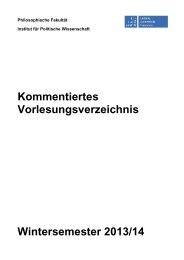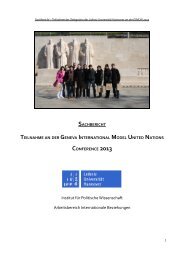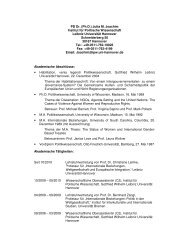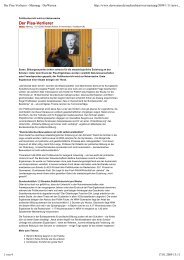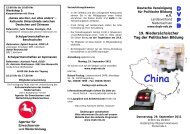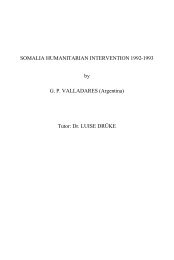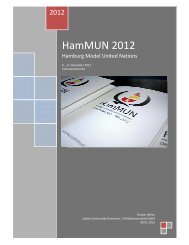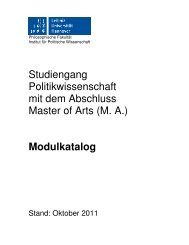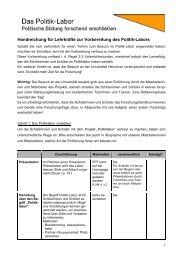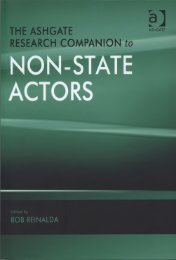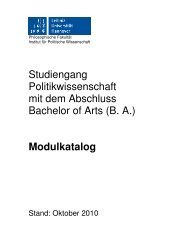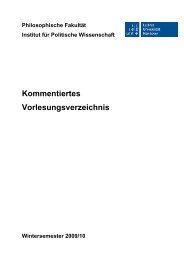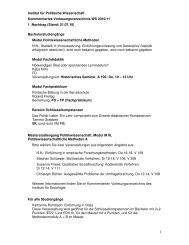Preventive Action for Refugee Producing Situations
Preventive Action for Refugee Producing Situations
Preventive Action for Refugee Producing Situations
You also want an ePaper? Increase the reach of your titles
YUMPU automatically turns print PDFs into web optimized ePapers that Google loves.
114 Chapter 3<br />
practically from the time of their arrival in the Spring of 1986, wanted to<br />
return to Nicaragua. Thousands of them did so spontaneously by crossing<br />
the Coco river, where KISAN (a successor group to MISURA, affiliated<br />
with the Union Nicaraguense de oposicion, UNO) prevented them from<br />
doing so, they sought the assistance of UNHCR.25 6 Since 1986, 13,501<br />
Miskitos and Sumos have sought UNHCR's assistance in returning<br />
The 1986 influx<br />
a) "Early warnings" signals and interviews to substantiate the signals.<br />
Early in<strong>for</strong>mation received and collected from Miskito Indians newly arrived<br />
at the refugee locations suggested by January 1986 that entire<br />
villages on the Nicaraguan side of the Coco River were being prepared <strong>for</strong><br />
displacement into Honduras on day X. In an attempt to substantiate this<br />
early warning in<strong>for</strong>mation, a fact-finding mission to the Honduran<br />
Mosquitia in mid-February 1896 was dispatched with the objective of<br />
examining the nature and potential implications of the refugee movements<br />
of the previous few months.<br />
__________________<br />
December 31,1987: 13,115 September 30,1988: 9,383(*)<br />
Documents of In<strong>for</strong>mation: HCR/HON/2/86/E April 1986 (<strong>for</strong> December<br />
1983-June 1986) and HCR/HON/2/88, April 1988 (<strong>for</strong> December 1986-<br />
April 1988). (*) The statistics <strong>for</strong> the September 1988 data are from<br />
UNHCR, "Numbers of <strong>Refugee</strong>s as of 30 September 1988", Table 2,<br />
Geneva, 1988.<br />
256 On December 1,1983, the Nicaraguan government decreed a general<br />
amnesty <strong>for</strong> the Miskitos, see OAS Report, op. cit., p.130, on the basis of<br />
which UNHCR facilitated voluntary repatriation to Nicaragua. After<br />
publicly admitting mistakes in its Atlantic Coast policy, the Nicaraguan<br />
government began to emphasize negotiation over warfare, permitted people<br />
to return to their original communities, and initiated discussions concerning<br />
autonomy of the Atlantic Coast. The voluntary repatriation ef<strong>for</strong>ts were,<br />
however, greatly hindered by the Indian contra organizations, as will be seen<br />
later in this section. But since mid-1986 the stream of repatriates continued<br />
to increase, enhanced by an "air bridge" to carry repatriates from Puerta<br />
Lempira in Honduras to Puerta Cabeza in Nicaragua, which had been<br />
arranged after lenghty negotiations between the governments of Honduras<br />
and Nicaragua and UNHCR. See Hansruedi Peplinski and Martin Diskin,<br />
Report of the ICVA Mosquitia Mission [ICVA — International Council of<br />
Voluntary Agencies], June 9,1987, p. 2.<br />
257 UNHCR statistics as of 1 October 1988.<br />
Analytical Discussion 115<br />
Out of the 1,859 new arrivals in Honduras between 15 December 1985<br />
and 28 February 1986, 258 808 persons were interviewed. More than half -<br />
446 - had entered the refugee locations directly from Nicaragua; 311 had<br />
arrived from the border area; and 51 were returning from the border area<br />
after having already been in the refugee locations.<br />
All the interviewees were asked to state the main reason they had come to<br />
the refugee locations in Honduras. Of the new arrivals from Nicaragua<br />
58% cited lack of food and medicine as a primary factor,<br />
30% wished to visit family living in Honduras; and 12%<br />
feared possible conflicts where they were living.<br />
Among new arrivals from the Honduran border region:<br />
50% indicated lack of food and medicine as a factor; 20%<br />
feared possible conflicts; 25% wished "not to be left behind";<br />
and259 5% wished to visit family in Honduras.<br />
Those reentering UNHCR refugee locations from the Honduran border,<br />
however, unanimously cited lack of food, medicine, and clothes as their<br />
chief motive <strong>for</strong> returning to the refugee sites.<br />
These statistics must, of course, be taken with a grain of salt For one<br />
thing, the questionnaires had to be designed in a neutral manner, and<br />
there<strong>for</strong>e could not include questions that would elicit responses of a political<br />
nature. Second, even though three different rooms were set up in<br />
which to conduct interview, the lack of privacy inherent in lining up refugees<br />
<strong>for</strong> center-based interviews exposed them to pressure and coaching.<br />
In retrospect, it would have been better to conduct random interviews in<br />
their huts. In addition, establishing the accuracy of translations was a<br />
problem. Although the refugees who served as interpreters were known to<br />
UNHCR, it was hard to determine to what extent they themselves were<br />
subject to pressure and threats by KISAN. Despite these shortcomings,<br />
however, the interviews were valuable <strong>for</strong> several reasons. First, they<br />
provided first quantifiable data on the interviewed group. Second, through<br />
in<strong>for</strong>mal discussions with the interviewees after finishing the<br />
_____________________<br />
258 Americas Watch, "With the Miskitos in Honduras," p. 10.<br />
259 This new category emerged among this group during the interviews.



